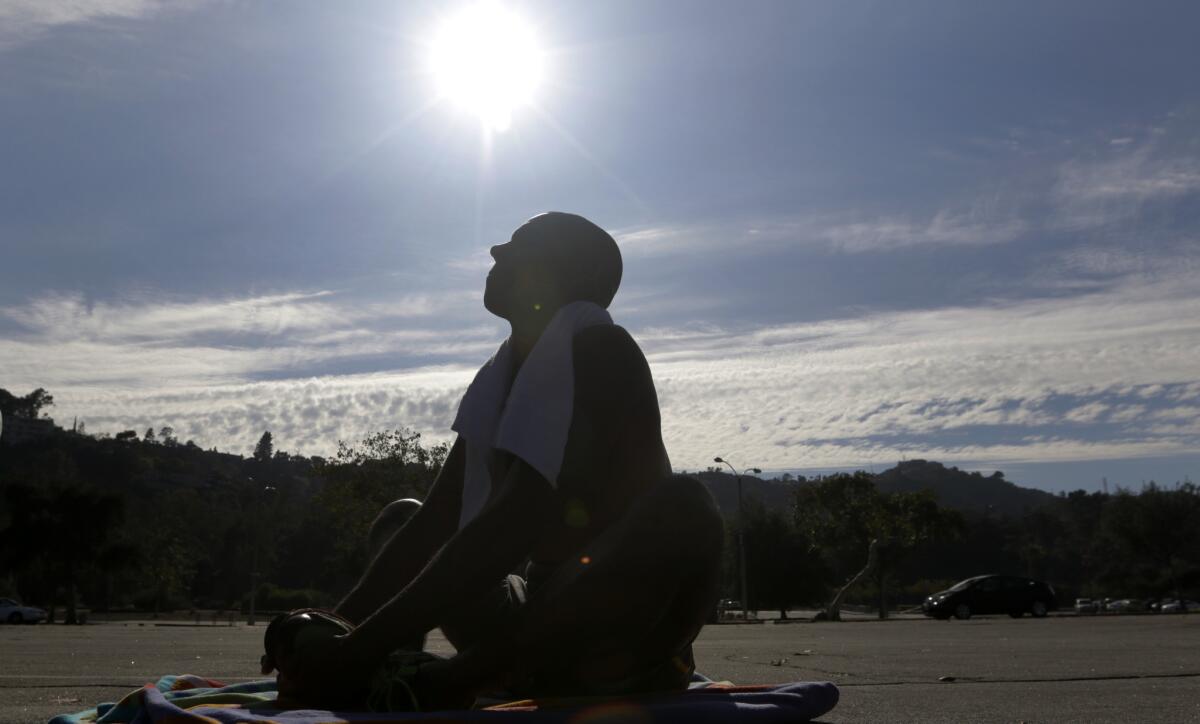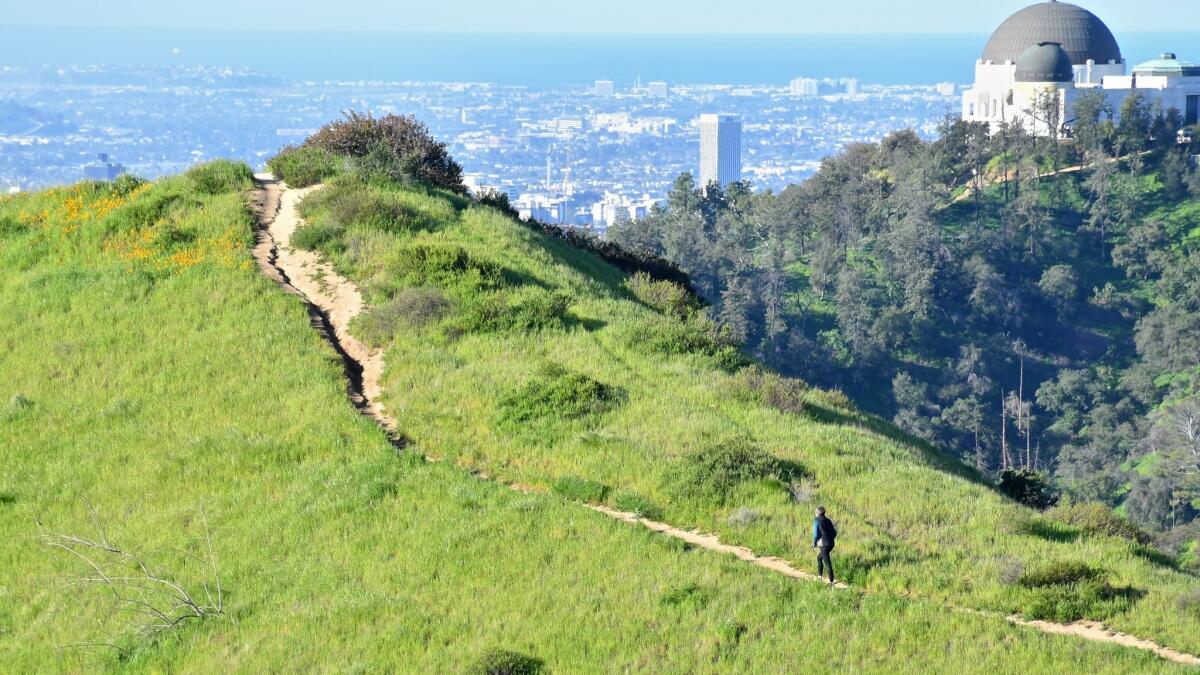Pandemic. Heat. And for the most vulnerable, no A/C

Welcome back to Boiling Point, a newsletter about climate change and the environment. I’m Sammy Roth.
Toward a more sustainable California
Get Boiling Point, our newsletter exploring climate change, energy and the environment, and become part of the conversation — and the solution.
You may occasionally receive promotional content from the Los Angeles Times.
I was scrolling through Twitter last week when I came across a new study from the University of Southern California, highlighted in a news release titled, “Urban heat waves imperil L.A.’s most vulnerable communities.” Intrigued, I clicked through and learned researchers had used electricity-use data for more than 180,000 households to study where in Southern California people don’t have air conditioning, and how those neighborhoods might be affected as climate change fuels more extreme heat waves.
The findings are timely, given that many Americans are sheltering at home, and summer is about to get started. As my colleagues Anna M. Phillips and Tony Barboza reported a few weeks ago, stay-at-home orders could increase the death toll of summer heat waves even as they save lives by slowing the spread of the coronavirus.
There were a few key charts in the USC study.
Here’s one of them, showing that across most of Southern California, people living in areas with higher poverty levels are less likely to have air conditioning:
The chart is sorted by “climate zones,” with each zone’s average summer temperature shown at the top. The falling bars show residents of poorer areas are less likely to have air conditioning than residents of wealthier neighborhoods. The two exceptions are in Climate Zone 6, which is along the coast and has relatively cool temperatures, and in Climate Zone 16, a mountainous region including Big Bear Lake, where researchers speculated that a high proportion of vacation homes may have skewed the data.
“Poverty was actually a better predictor of whether a household had access to air conditioning or not, even above climate,” Kelly Sanders, an energy expert and co-author of the study, told me via Zoom. “So a poor household is less likely to have air conditioning than a rich person. And that was a better predictor than even climate characteristics.”
Sanders and her co-authors compiled a list of the census tracts most vulnerable to rising temperatures, based on high poverty levels and homes lacking air conditioning. You can see the full list here if you want (search for “Section S7”). Many of the highest-risk areas are clustered in inland Los Angeles County, in cities such as Bell, Compton, Huntington Park, Lynwood and South Gate.
Here’s a map; you can see the most vulnerable census tracts outlined in yellow:
The left side is color-coded by the average number of extreme heat days — days with highs above 95 degrees Fahrenheit — in the latter part of the 20th century. The right side shows extreme heat days projected for the latter part of this century, under a worst-case climate change scenario. Even if society reduces emissions somewhat, we’ll all be experiencing more extreme heat days.
Lack of A/C isn’t the only problem.
Sanders and her co-authors found that households in richer areas typically use more air conditioning as temperatures rise than households in poorer areas. In other words, people who can’t afford high energy bills use less A/C than they might need.
“Even if they do have an air conditioning unit, they might not be able to run it, or run it with the intensity that they need to stay comfortable,” Sanders told me. “Just because you’re using any amount of electricity for cooling doesn’t necessarily mean that you’re using sufficient amounts to keep your family safe.”
I should stop here and note that extreme heat can be extremely deadly, especially for people who work outside, people without homes, young children, the elderly and people with preexisting medical conditions such as heart disease and diabetes, according to the Centers for Disease Control and Prevention. Heat-related deaths and illnesses are notoriously hard to track. But in Arizona’s Maricopa County, home to Phoenix, at least 182 people died from heat-associated causes in 2018.
Not being able to afford air conditioning puts low-income families at even greater risk. So does the COVID-19 pandemic, which has forced the closure of libraries, malls and other de facto public spaces where people without A/C might otherwise go to stay cool.
Sanders is hopeful that the USC study — and future research on this topic — will help policymakers support the people who need it most. That could mean adding cooling centers in the most vulnerable neighborhoods, providing rebates for A/C installations, or better targeting incentive dollars for weatherization programs, which reduce the amount of energy needed to cool a home.
Ever-more-intense heat waves pose a climate conundrum. Greater use of A/C means more energy use and more greenhouse gas emissions, adding to global warming. But maintaining the status quo means rising temperatures will continue to exploit the gap between rich and poor, disproportionately punishing people who bear the least responsibility for the climate crisis.
One study won’t solve the problem. But maybe it can help us all think a little differently, and seek out solutions.
Here’s the rest of this week’s news:
TOP STORIES
What happens when unpaid utility bills come due? Continuing with the theme from above, one saving grace for low-income households is that most utility companies aren’t shutting off people’s electricity, water or gas during the pandemic, even if customers can’t pay. But eventually those shutoff moratoriums will end, and the unpaid bills will come due, as Sarah D. Wire and Anna M. Phillips report for The Times. Consumer advocates are asking federal and state officials for a grace period for low-income households to pay their bills once the national emergency ends, and ideally some kind of financial support or bill forgiveness.
The University of California system has divested from fossil fuels, becoming the largest U.S. educational institution to do so. The university not only sold more than $1 billion in fossil fuel assets, as Teresa Watanabe reports; it also invested more than $1 billion in clean energy. (Ready for a stark contrast? Harvard University, the standard-bearer for American higher education, has rejected calls to divest. It did recently commit to achieving net-zero climate emissions in its endowment — 30 years from now.)
Griffith Park expands — and we’ve got a newsletter for that. Two items here. First, Jack Flemming reports that Griffith Park, a gem of open space at the heart of Los Angeles, is getting a bit bigger after a group of donors pitched in to buy 1.35 acres of land at the park’s edge. It’s great news for anyone who loves getting outside in Southern California. Second, The Times is launching a new email newsletter, The Wild, for people who love getting outside in Southern California. It’ll be fun! You can sign up here.

POLITICAL CLIMATE
In Sacramento, lawmakers continue to fight about the stuff they fought about before COVID-19. Case in point: Rosanna Xia wrote about a bill from Republican Sen. Patricia Bates that would revise the state’s Coastal Act, allowing homeowners in Orange and San Diego counties — but nowhere else — to build seawalls without strict oversight from the Coastal Commission. Supporters say the bill would protect people from rising seas, while critics say it would contribute to destruction of beaches in the long term.
California has sued the Trump administration for the 524th time. Actually it’s the 82nd time, but you believed me for a second, right? The latest lawsuit seeks to overturn the administration’s weakening of fuel-efficiency standards for cars and trucks, as Anna M. Phillips and Tony Barboza report. In another climate lawsuit, a federal appeals court sided against Big Oil, ruling that a group of California cities and counties can seek damages for climate change impacts in state courts, a significant victory for the litigants.
Another climate newsletter I love to read is Heated, by the journalist Emily Atkin. In a recent edition, she interviewed the Los Angeles-area climate activist RL Miller, who chairs the California Democratic Party’s environmental caucus and has been a thorn in the side of establishment Democratic figures for years, pushing them to get more aggressive on climate. Miller just got elected to the Democratic National Committee, and she gave Atkin a preview of the fierce message she’s got for DNC chair Tom Perez.
Consider subscribing to The Times
Your support helps us deliver the news that matters most.
Become a Los Angeles Times subscriber.
POWER STRUGGLES
PACE has come to an end in Los Angeles County. The first time I wrote about Property Assessed Clean Energy programs, I thought they sounded like a cool idea: Homeowners can take out loans for energy-efficiency upgrades and solar panels, and pay back the loans through their property taxes. But Andrew Khouri reports that L.A. County has ended its PACE program, following what he describes as “years of criticism that the county enabled predatory lending and put people at risk of losing their homes.”
An energy company wants to dam a remote side canyon of the Little Colorado River, near the Grand Canyon. The dams would be part of a “pumped storage” system to bank solar power for use at night, as Ian James reports for the Arizona Republic. You won’t be surprised to hear the project has been criticized by conservationists. I wrote recently about the growing number of pumped storage proposals in the American West, including one that would be built just outside Joshua Tree National Park.
What do you want to know?
When you think about California’s climate future, what keeps you up at night, and what gives you hope? What do you want to understand? What should I?
This newsletter is for you. I want to hear your questions, concerns and ideas. Email me or find me on Twitter.
ENVIRONMENTAL INEQUITY
I’ve included some stories the last few weeks about why pandemics could become more likely if humanity continues to destroy the environment. Now we’ve got a video explaining this phenomenon, from Nani Sahra Walker and Maggie Beidelman. The video focuses on the disproportionate harm wrought by the coronavirus on people who live in areas with high levels of air pollution — a serious concern in Southern California. There’s also a brief appearance by me, discussing potential solutions.
Millions of Americans lack access to quality parks, according to the Trust for Public Land. Here’s the story by Nina Lakhani for the Guardian. The Trust found that 62% of Los Angeles residents live within a 10-minute walk of a park, compared to just 51% in Riverside and 46% in Bakersfield. (I live in L.A., and my neighborhood is classified as having “very high need” for a park.) Quality green spaces are especially important right now, providing an outlet for exercise and fresh air when we’re all stuck at home.
ONE MORE THING
I grew up in Los Angeles, but for several years after college I lived in Palm Springs, where I learned to love Joshua Tree National Park. I even wrote some stories about the park’s namesake species, which California may soon list as an endangered species. So I was surprised to learn this week that one of the most commonly shared “fun facts” about Joshua trees is not actually a fact.
I’m sure I’ve repeated the oft-stated claim that Joshua trees are not really trees. But according to Chris Clarke, who lives near the national park and works as California desert program manager for the National Parks Conservation Assn., it’s not true.
In his Letter From the Desert newsletter this week, Clarke puts the myth to rest. There’s no widely accepted scientific definition of “tree,” he writes, that excludes Joshua trees.
Now I know. And now you know, too.
I’ll be back in your inbox next week. If you enjoyed this newsletter, please consider forwarding it to your friends and colleagues.




